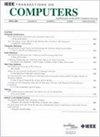DC-ORAM: An ORAM Scheme Based on Dynamic Compression of Data Blocks and Position Map
IF 3.6
2区 计算机科学
Q2 COMPUTER SCIENCE, HARDWARE & ARCHITECTURE
引用次数: 0
Abstract
Oblivious RAM (ORAM) is an efficient cryptographic primitive that prevents leakage of memory access patterns. It has been referenced by modern secure processors and plays an important role in memory security protection. Although the most advanced ORAM has made great progress in performance optimization, the access overhead (i.e., data blocks) and on-chip (i.e., PosMap) storage overhead is still too high, which will lead to problems such as low system performance. To overcome the above challenges, in this paper, we propose a DC-ORAM system, which reduces the data access overhead and on-chip PosMap storage overhead by using dynamic compression technology. Specifically, we use byte stream redundancy compression technology to compress data blocks on the ORAM tree. And in PosMap, a high-bit multiplexing strategy is used to achieve data compression for binary high-bit repeated data of leaf labels (or path labels). By introducing the above compression technology, in this work, compared with conventional Path ORAM, the compression rate of the ORAM tree isDC-ORAM:基于数据块动态压缩和位置映射的 ORAM 方案
无关RAM (ORAM)是一种有效的加密原语,可以防止内存访问模式的泄漏。它被现代安全处理器所引用,在存储器安全保护中起着重要的作用。虽然目前最先进的ORAM在性能优化方面已经取得了很大的进步,但是访问开销(即数据块)和片上(即PosMap)存储开销仍然过高,这将导致系统性能低下等问题。为了克服上述挑战,本文提出了一种DC-ORAM系统,该系统通过使用动态压缩技术降低了数据访问开销和片上PosMap存储开销。具体来说,我们使用字节流冗余压缩技术来压缩ORAM树上的数据块。在PosMap中,采用高位复用策略实现叶标签(或路径标签)二进制高位重复数据的数据压缩。通过介绍上述压缩技术,在本工作中,与传统的Path ORAM相比,ORAM树的压缩率为52.9%,PosMap的压缩率为40.0%。在性能方面,与传统的Path ORAM相比,我们提出的DC-ORAM系统将平均延迟降低了33.6%。此外,我们还将本文提出的压缩技术应用于Ring ORAM系统。通过比较发现,在与Path ORAM相同的压缩比下,我们的设计仍然可以将延迟平均降低21.5%。
本文章由计算机程序翻译,如有差异,请以英文原文为准。
求助全文
约1分钟内获得全文
求助全文
来源期刊

IEEE Transactions on Computers
工程技术-工程:电子与电气
CiteScore
6.60
自引率
5.40%
发文量
199
审稿时长
6.0 months
期刊介绍:
The IEEE Transactions on Computers is a monthly publication with a wide distribution to researchers, developers, technical managers, and educators in the computer field. It publishes papers on research in areas of current interest to the readers. These areas include, but are not limited to, the following: a) computer organizations and architectures; b) operating systems, software systems, and communication protocols; c) real-time systems and embedded systems; d) digital devices, computer components, and interconnection networks; e) specification, design, prototyping, and testing methods and tools; f) performance, fault tolerance, reliability, security, and testability; g) case studies and experimental and theoretical evaluations; and h) new and important applications and trends.
 求助内容:
求助内容: 应助结果提醒方式:
应助结果提醒方式:


